The verdant, waterfall-studded Sahyadri Hills are home to many exotic forts and royal wadas of MaharashtraWhile some of Maharashtra’s fabulous forts and royal Wadas offer great trekking or sight-seeing holidays, others have been turned into super-luxurious resorts and weekend getaways. While hilltop forts like Raigad and Shivneri challenge trekkers with their brooding ramparts and historic nostalgia, Panhala and Jadhavgadh invite lotus-eaters to enjoy the sheer luxury of resort life. All of these are within easy reach from Mumbai and Pune…
The Sahyadris Hills – or Western Ghats as they are also known – run down the west coast of India like a multi-coloured ribbon with their flowering forests and cascading streams. These rugged mountains and the thin sliver of the west coast of India alongside are home to hundreds of forts and wadas or royal residences from the Maratha period of history. The historic structures – over 350 of them – are the pride of the state and attract lakhs of visitors every year. While some of them have been ravaged by time and climate, there are some that have been resurrected for their historical importance and others that have been rediscovered for their tourism potential. Most of the forts were built during the two centuries of Maratha power – from Chhatrapati Shivaji’s lifetime (1627-1680) to the final fall of the Maratha Empire after the 1857 War of Independence against the British.
The Marathas were masters at building strong ramparts and forts of three kinds – hilltop forts on craggy mountain peaks, land forts and sea forts. Examples of all three kinds of forts continue to attract historians and tourists alike. Probably, the majority of hilltop ramparts were built as watch-towers and residences for the commanders of the army. Sea forts were obviously meant to keep a watch on any approaching enemy from the sea and land forts were either residences or administrative centres for the rulers. The Marathas were great warriors and waged endless wars to establish Swarajya beginning with the 17th century, chasing the Moghuls in the north up to Delhi and in the south beyond Tanjore!
Unfortunately, today most of these inaccessible forts lie dilapidated, either because they were destroyed by the Moghuls or the British or because of the sheer passage of time! The Maratha kings and sardars also built Wadas or royal residences which are heritage sites today. Some of the prominent forts and Wadas that tell tales of Maratha courage and valour are: Pratapgadh, Lohagadh, Harishchandragadh, Ahmednagar Fort, Doulatabad or Devgiri Fort, Panhala Fort, Raigad Fort, Shivneri Fort, Sinhagad Fort and Sindhudurg and Murud-Janjira Forts along the Konkan seacoast. Among royal residences, Shaniwar Wada, Lal Mahal and Mastani Mahal in Pune and Phadnis Wada in Menavli near Wai attract many tourists.
Some forts have become nostalgic sentinels of a proud era of Maharashtra’s history. Among these are three memorials to the great Maratha King Chhatrapati Shivaji, the founder of the Maratha Empire and a superhero of millions of Indians. Shivaji was born in the Shivneri fort in 1627. Built near the Nane Ghat, this fort offers a sweeping view of the Konkan Plateau and is a favourite among trekkers. Seven imposing gates or Darwazas lead to the inner sanctum of the fort and a temple of Shivai Devi – after whom Shivaji was named – stands as a reminder of his illustrious life. Shivaji’s coronation was celebrated in the Raigad fort in 1674 making this fort a place of pilgrimage for generations. Pratapgadh on the Krishna River is the site where Shivaji defeated the Moghul Sardar Afzal Khan. All these forts are popular among adventure lovers.
The Wadas of the Maratha and Peshwa period, on the other hand, represent the turbulence and traditions of the era. Some of them are magnificent and others are private, solitary structures on the banks of rivers. While the city of Pune boasts the grand Shaniwar Wada, at the foot of Pratapgadh is Menavli, where Nana Phadnis, the famous prime minister of the Peshwas, built his own residence overlooking the Krishna River. Shaniwar Wada celebrates Maratha culture in a grandiose manner. Bajirao Peshwa, whose statue adorns the courtyard, chose the site for the palace which took two years to complete at a fabulous cost of Rs.16, 120! Over the years, successive Peshwas decorated the Diwankhanas and private rooms with beautiful architectural motifs and built Darwazas of grandeur. Today, the impressive structure of six storeys has been resurrected and illuminated for tourists who come from all over India to see the past glory of the Peshwas.
Phadnis Wada near Wai, on the other hand is a simple home, with rooms surrounding a courtyard. The unique feature of this nostalgic residence is the original portrait of Mastani, the beautiful courtesan with whom the Peshwa Bajirao I was in love. Other than these, the Lal Mahal, the Mastani Mahal (now recreated in Pune’s Raja Kelkar Museum) and other residences offer interesting glimpses of the gracious lifestyle of the royals of the Maratha era.
In recent years, two major forts have been resurrected and redesigned as luxurious resorts by either government agencies or private hospitality companies. The first is Panhala Fort which has been developed as a popular hill station destination by the Maharashtra Government as well as the Hotelier Group. Just 18 km from Kolhapur, Panhala Fort traces its origin to the 12th century. Spread over seven kilometers, it has a colourful history of several dynasties ruling from its massive ramparts and grand residences. Its Teen Darwazas as well as the intricate pathways inside the fort are a mesmerising spectacle for visitors. Because of Panhala’s clement weather, it has become a popular holiday destination for celebrities during monsoon as well as the mild winter of Maharashtra.
However, the most luxurious redeveloped fort is Jadhavgadh, standing just 22 kms from Pune. Situated in the stunning, untouched mountain scenery of Saswad, this fort – built by the Maratha nobleman Pilaji Jadhav in 1710 as a residence – commands a spectacular view of the deep ravines and dark forests around. It has a chequered history of the courage shown by Pilaji Jadhav, the brave general of the Maratha army. The 18th century ramparts have been restored to their original glory so as to bring back a glimpse of the unimaginable royal lifestyle of the bygone era. The outstanding feature of this fort-resort is the imposing Museum Room, which is a treasure of the historic artifacts of the state and is open to the public for viewing. Jadhavgadh is a heritage hotel imbued in the history and culture of Maharashtra. Its main Darwaza, the solid rock stairways and residential quarters are imposing but not heavily decorative. Developed by Kamat Hotels, the fort’s original 300-year-old structure has been preserved carefully while designing the rooms which fit naturally on the side walls of the fort. With its deluxe rooms, premium rooms with hill-view balconies and luxurious suites – plus the world-class restaurants – the resort offers unmatched holiday luxury. Near the fort stands a historic temple of Shiva which makes the resort a popular venue for weddings and celebrations with grand illuminations, themes and facilities for which are offered by the resort. Within the fort, a heritage temple of Ganesh attracts devotees. Jadhavgadh is also attractive to those who wish to explore the wilder side of the Sahyadri Hills. The famous Khandoba temple of Jejuri, the Mastani Talao and the Purandar Fort are near the resort.
Additionally, well-equipped tents, overlooking the fort on one side and the water Kund under the hillock on the other, provide an instant and stress-free connection with Nature as herds of deer walk around early in the morning. Languorous walks, a luxurious spa and a peaceful swimming pool complete the picture of luxury.
Jadhavgadh has been turned into one of India’s finest heritage resorts and stands as an example for the hospitality industry which could look for similar sites for development. “Antiquity and heritage are my passion,” says Green Hotelier Vithal Kamat, Chairman, Kamat Hotel Group, “I have admired and actively looked for such sites in many parts of India. Many forts in Maharashtra were destroyed by the Moghuls and the British and yet others were neglected by the descendants of the royal families or the government in the last 60 years. Inaccessible and in a dilapidated condition, these structures are difficult to rebuild or to market. But we are making a Herculean effort to save some sites in the Konkan area and have set our sights on a heritage property near Jagannath Puri in Orissa. Jadhavgadh has been such a success that many owners of such properties are looking for joint ventures! The future looks good!”
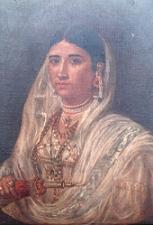 |
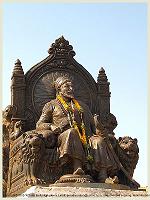 |
| Forts Mastani portrait at Phadnis Wada near Wai |
Forts Raigad memorial to Shivaji |
| |
|
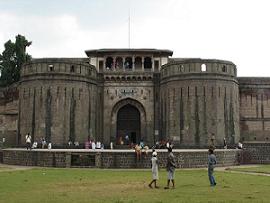 |
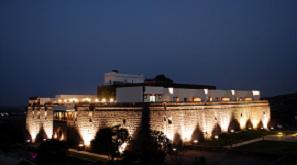 |
| Forts Shaniwar Wada |
Jadhavgarh Fort |
| |
|
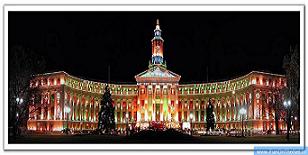 |
|
Forts Shaniwar Wada lit up
|
Also see pictures of
1. Raigarh Fort
2. Pratapgarh Fort
3. Singhad Fort